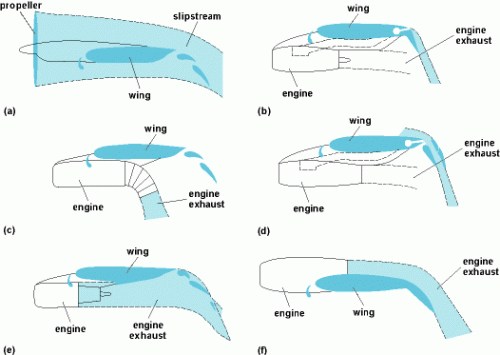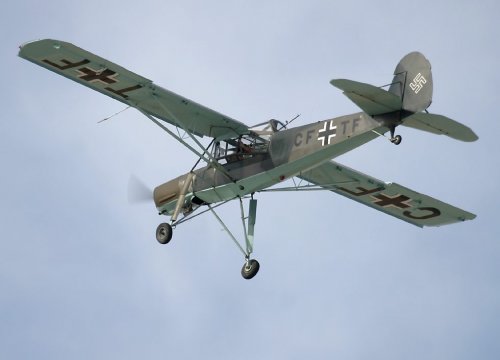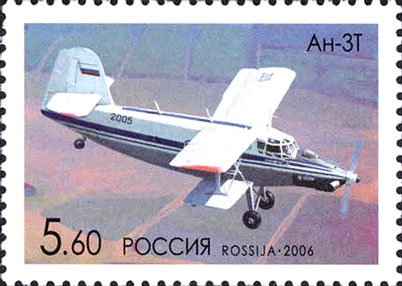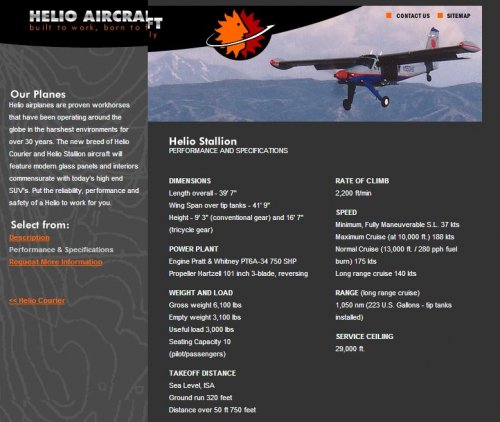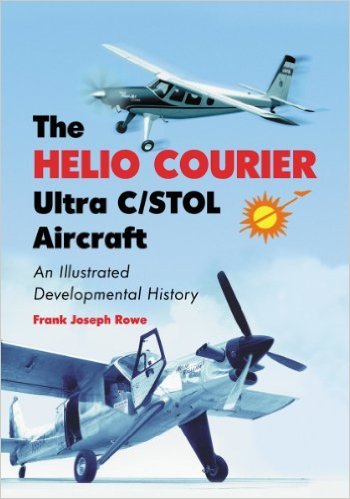You are using an out of date browser. It may not display this or other websites correctly.
You should upgrade or use an alternative browser.
You should upgrade or use an alternative browser.
The Best "Possible" STOSL Aircraft: Lets design it
- Thread starter Broncazonk
- Start date
Broncazonk
What the hell?
- Joined
- 29 August 2011
- Messages
- 134
- Reaction score
- 5
- Joined
- 21 December 2006
- Messages
- 1,132
- Reaction score
- 614
Powered lift/BLC like a modern Marshall MA.4 (http://www.pprune.org/aviation-history-nostalgia/417799-marshall-ma-4-boundary-layer-aircraft.html) could be worth another look to get 'ultra stol' for a prop aircraft. Digital engine control would probably make sense.


- Joined
- 27 May 2007
- Messages
- 676
- Reaction score
- 36
I think the design space has two obvious "humps".
If you need to be able to cope with engine out, you probably can use only modest thrust (or need four engines and it gets expensive). Then you need a pretty big wing and modest flaps.
If you can rely on the engine(s), then put a really powerful one in and you can do a lot. You don't need much wings anymore.
http://www.youtube.com/watch?v=mCELX-NgqFQ
You could do even better than above with a variable incidence propeller as it's very quick to "throttle". Computers for control. Then it's a short way to a tilt rotor from that. All that probably gets maintenance intensive like helicopters again. So maybe do it just big enough to be able to land in a short distance without the tilt part.
We have slightly-bigger-than-garage companies building rockets that land on their tails with centimeter accuracy. Control possibilities are now better than 50 years ago so some old concepts should be revisited.
If you need to be able to cope with engine out, you probably can use only modest thrust (or need four engines and it gets expensive). Then you need a pretty big wing and modest flaps.
If you can rely on the engine(s), then put a really powerful one in and you can do a lot. You don't need much wings anymore.
http://www.youtube.com/watch?v=mCELX-NgqFQ
You could do even better than above with a variable incidence propeller as it's very quick to "throttle". Computers for control. Then it's a short way to a tilt rotor from that. All that probably gets maintenance intensive like helicopters again. So maybe do it just big enough to be able to land in a short distance without the tilt part.
We have slightly-bigger-than-garage companies building rockets that land on their tails with centimeter accuracy. Control possibilities are now better than 50 years ago so some old concepts should be revisited.
Broncazonk
What the hell?
- Joined
- 29 August 2011
- Messages
- 134
- Reaction score
- 5
mz said:I think the design space has two obvious "humps". If you need to be able to cope with engine out, you probably can use only modest thrust (or need four engines and it gets expensive). Then you need a pretty big wing and modest flaps.
If you can rely on the engine(s), then put a really powerful one in and you can do a lot. You don't need much wings anymore.
You could do even better than above with a variable incidence propeller as it's very quick to "throttle". Computers for control.
We have slightly-bigger-than-garage companies building rockets that land on their tails with centimeter accuracy. Control possibilities are now better than 50 years ago so some old concepts should be revisited.
Really good post. I've been thinking about "engine out" as well--a condition that gets scary in a great big hurry when you're close to the ground, not to mention in a hover. I keep going back to my STOSL (Short Takeoff Short Landing) concept where we surrender hover (also vertical takeoff and landing) capability for a steep takeoff and landing ability. A engine out during takeoff or landing in a STOSL might mean a computer assisted (instant) transition into the best possible flight envelope--I really think the concept requires fly-by-wire and computer control (over watch) of the flight envelope during landing and takeoff. (I love the computer-controlled variable-incidence prop idea.) I think a twin-engine Dynavert-concept with the engines mounted as in-board as possible AND on top the wings would be a great place to start.
So much money has been spent on computer-assisted flight controls for inherently unstable aircraft, I'm wondering what could be achieved with an F-22 / F-35 quality computer program helping an inherently stable STOSL aircraft to get up and down in a hurry.
Bronc
Broncazonk
What the hell?
- Joined
- 29 August 2011
- Messages
- 134
- Reaction score
- 5
harrier said:Powered lift/BLC like a modern Marshall MA.4 (http://www.pprune.org/aviation-history-nostalgia/417799-marshall-ma-4-boundary-layer-aircraft.html) could be worth another look to get 'ultra stol' for a prop aircraft. Digital engine control would probably make sense.

I am utterly amazed by this concept--it's so innovative. It might be possible to change the angle of the turbine. It looks like it would be providing forward thrust at a time when you want to be slow. Bronc
Kryptid
ACCESS: Secret
- Joined
- 12 March 2009
- Messages
- 276
- Reaction score
- 33
In terms of thinking outside of the box, perhaps the Magnus Effect would have utility here? http://en.wikipedia.org/wiki/Magnus_effect#In_flying_machines
Perhaps some sort of retractable, spinning rollers on the sides of the aircraft could increase lift and therefore reduce take-off run distance? There would be added weight and maintenance to think of, but the faster your spin the rollers, the shorter the take-off run should be. The rollers could be powered by a turboshaft within the fuselage or with some other shaft that draws power from the main engines (whatever they may be).
Perhaps some sort of retractable, spinning rollers on the sides of the aircraft could increase lift and therefore reduce take-off run distance? There would be added weight and maintenance to think of, but the faster your spin the rollers, the shorter the take-off run should be. The rollers could be powered by a turboshaft within the fuselage or with some other shaft that draws power from the main engines (whatever they may be).
- Joined
- 21 December 2006
- Messages
- 1,132
- Reaction score
- 614
I am utterly amazed by this concept--it's so innovative. It might be possible to change the angle of the turbine. It looks like it would be providing forward thrust at a time when you want to be slow. Bronc
The MA.4 was designed (and achieved IIRC) a CL of 5 through BLC. Any residual thrust from the turbine and fan was of most use to trim the aircraft I would imagine. But the idea of BLC was also tried in the Mississippi State XAZ-1 Marvelette and the XV-11 MARVEL
http://en.wikipedia.org/wiki/Mississippi_State_University_XAZ-1_Marvelette
http://en.wikipedia.org/wiki/XV-11_Marvel
Smooth variable camber wings and turbine BLC suction featured, and the MARVEL reportedly achieved take-off ground rolls of 60m and landing ground runs of 145m. CL max of the MARVEL was 3.5.


Broncazonk
What the hell?
- Joined
- 29 August 2011
- Messages
- 134
- Reaction score
- 5
- Joined
- 27 May 2007
- Messages
- 676
- Reaction score
- 36
You want low cost so a single engine and a large cargo space to be useful. Probably something like a turbine An-2, the An-3:
You make the wing big, thick and cambered. That will reduce top speed but improve max lift. But you probably wanted a cheaper alternative to helicopters anyway.
You make the wing big, thick and cambered. That will reduce top speed but improve max lift. But you probably wanted a cheaper alternative to helicopters anyway.
Attachments
- Joined
- 18 June 2009
- Messages
- 1,290
- Reaction score
- 2,102
Broncazonk said:What would a Storch look like today? Turbine powered? Composite wings? It's such a great design already, how could it be improved?
Bronc
[font=verdana, geneva, arial, sans-serif]It might look like a Helio Stallion. [/font]
[font=verdana, geneva, arial, sans-serif]The Storch had great STOL performance, but it couldn't carry much and was slow. The Stallion can carry 10 people and has a useful load of 3000 lbs. It can clear the 50 ft. obstacle in a little over half the distance of the Turbo Porter and is significantly faster. [/font]
[font=verdana, geneva, arial, sans-serif]Modifying the Storch would be a huge development effort and would have a very hard time coming anywhere near the utility of the Helio Stallion. The original Helio company had larger twin PT-6 aircraft on the drawing board that would have flown like the Stallion with greater payload capability.[/font]
Attachments
lastdingo
Blogger http://defense-and-freedom.blogspot.de/
Broncazonk said:What would a Storch look like today? Turbine powered? Composite wings? It's such a great design already, how could it be improved?
Bronc
The bush pilots customized Super Cubs are today's Storch.
http://www.youtube.com/watch?v=tkQMYhefIok
It takes a low wing loading, adapted landing gear, flaps, flaps, better flaps, good power/weight ratio and some wind extra is a big plus. Fixed wing aircraft can actually land and take off vertically, or even backwards - it only takes enough and steady wind.
- Joined
- 18 June 2009
- Messages
- 1,290
- Reaction score
- 2,102
The Helio Stallion has a minimum fully maneuverable speed of 37 kts which compares favorably with most of the other STOL aircraft mentioned here.
Its big advantage over the slow flying competition is cruise speeds. The fastest Just Aircraft airplane has a cruise speed of 110 kts. The Helio Stallion has a max cruise of 188 kts, normal cruise of 175 kts, and long range cruise of 140 kts. When coming up with a "Best Possible STOL Aircraft", controlled slow flight is a given but the ability to cover distance and carry cargo has to be included in the mix. If you fly a 110 kt cruise airplane into a 10 kt headwind, your ground speed made good will be 100 kts or less. A distance that could be covered from sunrise to sunset in the Helio Stallion would take another day in a slower aircraft. Higher cruise speed means more ground covered while the sun shines and it can carry a lot more than most here.
Its big advantage over the slow flying competition is cruise speeds. The fastest Just Aircraft airplane has a cruise speed of 110 kts. The Helio Stallion has a max cruise of 188 kts, normal cruise of 175 kts, and long range cruise of 140 kts. When coming up with a "Best Possible STOL Aircraft", controlled slow flight is a given but the ability to cover distance and carry cargo has to be included in the mix. If you fly a 110 kt cruise airplane into a 10 kt headwind, your ground speed made good will be 100 kts or less. A distance that could be covered from sunrise to sunset in the Helio Stallion would take another day in a slower aircraft. Higher cruise speed means more ground covered while the sun shines and it can carry a lot more than most here.
CxxTxx
You ate my glittery ponies?
- Joined
- 9 May 2013
- Messages
- 54
- Reaction score
- 4
Does anyone know if the company that makes/made the Helio Stallion is still in business? Their website doesn't look like it.
http://www.helioaircraft.com/
Update: Nope. Emails to the company are returned as undeliverable. What a shame.
http://www.helioaircraft.com/
Update: Nope. Emails to the company are returned as undeliverable. What a shame.
- Joined
- 18 June 2009
- Messages
- 1,290
- Reaction score
- 2,102
This is the only book I know of about Helio and its aircraft:
"The Helio Courier Ultra C/Stol Aircraft: An Illustrated Developmental History" by Frank Joseph Rowe
http://www.amazon.com/Helio-Courier-Ultra-Stol-Aircraft/dp/0786477199/ref=sr_1_10?s=books&ie=UTF8&qid=1439258946&sr=1-10&keywords=helio
Many pictures as well as 3 views of Helio aircraft.
"The Helio Courier Ultra C/Stol Aircraft: An Illustrated Developmental History" by Frank Joseph Rowe
http://www.amazon.com/Helio-Courier-Ultra-Stol-Aircraft/dp/0786477199/ref=sr_1_10?s=books&ie=UTF8&qid=1439258946&sr=1-10&keywords=helio
Many pictures as well as 3 views of Helio aircraft.
Attachments
lastdingo
Blogger http://defense-and-freedom.blogspot.de/
Broncazonk said:Hyopothetical question--one that I've been pondering for years. If you were designing a STOSL (Short Takeoff Short Landing) aircraft that would be like a PC-6, or Turbo-Beaver, in size but would be much, much better at STOSL, what would be its design features?
"Short Takeoff Short Landing"
That' STOL, and you're thinking of ESTOL:
"Extremely Short Take Off and Landing
two small PTL engines mounted on high wings with propeller stream adding to lift.
double vertical tail in propeller streams.
huge flaps along full wingspan (use of ailerons as flaps).
very lightweight construction
"balloon" low pressure tires on legs tricycle landing gear that allows for a high AoA (tail raised) and allows for a high sink rate on landing
seats that mitigate the impact of a hard landing well
cockpit windows that allow the pilot to see the landing area even with high AOA
possibly canard layout (horizontal tail generating lift instead of downward force in flight)
rather thick, low speed-optimized wing profile
engine exhaust (turbine!) used for extra lift (blown flaps, some coanda - whatever)
engine exhaust possibly used for control (as with Harrier, NOTAR) to provide control at very low altitudes
helium-filled unused hull and wing volume ( ;D ;D ;D )
.. and the pilot would have pyrotechnics to drop for wind observation based on smoke movements ;D
BTW, the German experimental STOl aircraft LF-1 Zaunkönig of 1940's and 1950's had
51 hp
355 kg take-off weight
65m take-off on grass
47 kph minimum speed
Similar threads
-
-
“The Arbalest”: A Light Attack Armed Reconnaissance (LAAR) Aircraft
- Started by Stargazer
- Replies: 0
-
-
-
Resin kits at the price of Short Run Injected Kits ??!! Yes, it is possible !!
- Started by Desert Dawn
- Replies: 3

